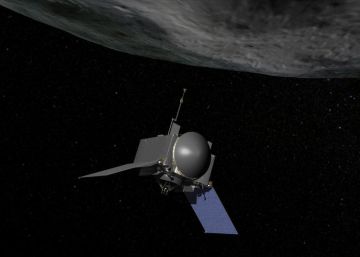The probability that a space rock fall on the head a person is minimal, but it exists. On August 14, 1992 a Ugandan boy walking in his village, Mbale, when a pebble with only three grams crossed a banana tree and bounced off his head. It was a tiny fragment of a meteorite with a ton that will spray just before the meeting with the atmosphere, to 14 kilometers in altitude, causing a shower of small meteorites.
Nothing happened to the boy Mbale, but it could have been much worse. There is a chance in 2,700 that the Bennu asteroid, which has about 500 meters in diameter, is colliding with the Earth in about 150 years. If this happens, a crater five kilometers in diameter will be formed, releasing an energy 70,000 times higher than the Hiroshima atomic bomb, according to the calculations of NASA
the purpose of the probe, which will be launched on 8 September, is to reach the asteroid and return with samples
But there is no reason to worry too much. The probability of someone dying in a traffic accident is 1 to 113, according to US data. The Bennu asteroid, on the other hand, can have a major impact on human knowledge about how the planets were formed, how life began on Earth and how it probably would have been originated elsewhere in the Solar System. NASA will launch on 8 September, at 19.05 local time from Cape Canaveral, the OSIRIS-REx spacecraft, with a mission to land on the asteroid, collect fragments of it and return home.
“No one You have to worry in any way. The cumulative probability of an impact is 0.037%, and that there the XXII century end, “explains the head of the mission, Mike Donnelly’s Goddard Space Flight Center, NASA. And reassures us: “Until then, the data collected by OSIRIS-REx will help us to make better predictions about the orbit of Bennu.”
This will not be the first outward mission and back of an asteroid. The Japanese spacecraft Hayabusa landed on the asteroid Itokawa in 2005. Five years later, he returned with samples from which one might say that asteroids like Itokawa, with rocky material type S, are the source of most meteorites that fall on Earth. Now, NASA hopes to collect between 60 and 2,000 grams of Bennu, so, in theory, find organic molecules such as amino acids, the “building blocks” that have managed to give rise to life on Earth about 4 billion years.
the Bennu can house the ‘bricks’ that managed to give rise to life on Earth about 4 billion years
Osiris probe REx, which weighs about two tons, will reach the asteroid Bennu in 2018. Those responsible for the mission opted for the point of sample collection after to map its surface. The samples will be collected by the robotic arm of the probe. It will be a kind of time capsule of the first moments of the solar system, which will be examined, if all goes well, on his return to Earth in 2023.
NASA’s mission has also another goal: learn to extract ore from asteroids. In 2013, the US space agency even commented that “to satisfy the appetite of civilization,” mining companies are exploring new frontiers, opening mines kilometers deep subsoil and even in the deep ocean. The asteroids are full of precious metals.
“A small asteroid type S, 10 meters, contains about 650 tons of metal, with about 50 kilograms of platinum and gold,” said the occasion, Dante Lauretta, Arizona University researcher and chief scientific mission. Other asteroids, type M, can multiply these amounts up to 10 times. But there are many obstacles for space mining. The first is that it is not profitable. The OSIRIS-REx mission will cost around EUR 870 million (about 3.1 billion reais). Another difficulty is that it requires experience to analyze the natural resources of an asteroid and extract them. The probe will the Bennu will help solve this problem.
Donnelly, the head of the mission, admits the existence of numerous risks, from the most common, for the launch of any rocket, even their own asteroid . “The Bennu may have its own satellites or barriers that we have not seen from Earth. This could compromise the ability to collect samples. We can not know that before the probe comes, “he says. Engineers also ignore how the asteroid is exactly, and it’s a safe place to land. “In addition, many internal systems the equipment will have to work for seven years for the probe collects samples, put them in the return capsule, leave the asteroid and is triggered at the right time to land after the Utah desert,” he adds Donnelly. “The risk is inherent to space exploration”
SHORT OUR PAGE ON FACEBOOK AND GET INFORMATION ON YOUR FACE
Source: EL Country – Brazil Edition

No comments:
Post a Comment